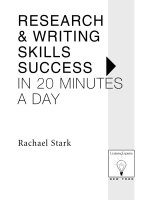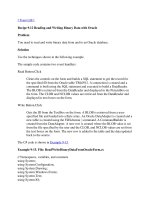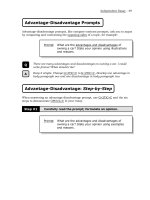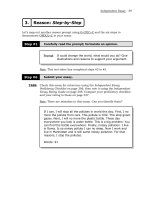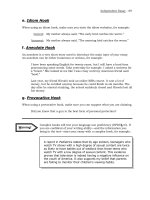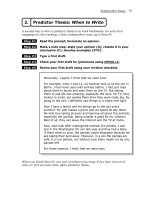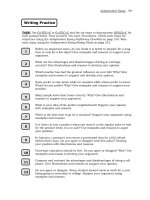Tài liệu RESEARCH AND WRITING SKILLS SUCCESS PART 18 pdf
Bạn đang xem bản rút gọn của tài liệu. Xem và tải ngay bản đầy đủ của tài liệu tại đây (67.49 KB, 7 trang )
107
– ANSWER SHEET–
Post-Test
1. abcd
2. abcd
3. abcd
4. abcd
5. abcd
6. abcd
7. abcd
8. abcd
9. abcd
10. abcd
11. abcd
12. abcd
13. abcd
14. abcd
15. abcd
16. abcd
17. abcd
18. abcd
19. abcd
20. abcd
21. abcd
22. abcd
23. abcd
24. abcd
25. abcd
26. abcd
27. abcd
28. abcd
29. abcd
30. abcd
31. abcd
32. abcd
33. abcd
34. abcd
35. abcd
36. abcd
37. abcd
38. abcd
39. abcd
40. abcd
41. abcd
42. abcd
43. abcd
44. abcd
45. abcd
46. abcd
47. abcd
48. abcd
49. abcd
50. abcd
ing questions.
1. To plagiarize someone else’s work means
to
a. use too many quotations.
b. take someone else’s point of view.
c. list too many facts or statistics.
d. copy and neglect to credit work that is
not your own.
2. When using parenthetical citations, the
author of the book and the page number
a. are not listed alphabetically.
b. are written in parentheses next to the
statement that requires
documentation.
c. appear in the table of contents.
d. have an accompanying illustration.
3. An annotated bibliography provides
important information to the reader
because
a. it states more sources than a regular
bibliography.
b. it describes precisely how each book
was useful and what material it
contained.
c. it is more professional than a regular
bibliography.
d. all professors prefer an annotated
bibliography.
4. In order to avoid plagiarizing a source,
every note card needs to have
a. your thesis statement in its final form.
b. the title, author, publisher, date/place
of publication, and page number of
the book you are using.
c. an introductory paragraph from the
book you are using.
d. a conclusion from the book you are
using.
5. If you use two or more books by the
same author, the proper bibliographical
format is to
a. write an acknowledgement to that
author.
b. alert your reader to seek other sources.
c. make sure that the author’s work has
not been falsified.
d. use an underline followed by a period.
6. Two of the most commonly used style
manuals for research papers are
a. the New York Times and the Oxford
English Dictionary.
b. the Chicago Manual of Style and the
Oxford English Dictionary.
c. the Oxford English Dictionary and the
Merriam-Webster Dictionary.
d. the Modern Language Association
(MLA) manual of style and the
American Psychological Association
(APA) manual of style.
– POST-TEST–
109
7. It is important for a writer to have
passion about a subject as long as the
writer
a. does not base his or her entire paper
on emotional feeling alone and
provides enough solid evidence to
back his or her argument.
b. does not have a personal stake in the
material or subject matter.
c. is able to sustain that emotion
throughout the course of the paper.
d. includes plenty of eyewitness accounts
and first-hand information.
8. Non-fiction material refers to any
material that
a. the writer has reviewed before writing
the paper.
b. comes from a variety of different
sources.
c. contains strictly factual information.
d. refers to secondary sources in the
bibliography.
9. Read the following statement.
“The Chief of Police in Dallas expected
Kennedy’s reception to be a good one.
He was completely unaware that events
would take a precipitous turn.”
This is a good example of
a. first person narration.
b. first person plural narration.
c. an informal writing style.
d. third person narration.
10. When interviewing people or experts in
a particular field, you should prepare
a. at least five basic questions
beforehand.
b. an extra copy of your research paper.
c. a guide to your subject matter.
d. a comprehensive bibliography.
11. When citing electronic information, it is
important to be as accurate as possible
because
a. most websites contain more
information than books.
b. electronic websites and information
are constantly being updated.
c. too many people use the web for
research.
d. electronic information is never
reliable
12. Any factual material that is quoted
directly or paraphrased from a text must
a. appear in the introductory paragraph.
b. express the opinion of the writer only.
c. have an accompanying footnote, end-
note, or parenthetical citation.
d. sufficiently get the attention of the
reader.
– POST-TEST–
110
13. Internet or electronic sources of
information can be tricky to document
and include in footnotes or citations if
they
a. do not come from an established
website with an official electronic
address.
b. come from an international website.
c. are not available in hard copy.
d. do not provide accompanying web
links.
14. The problem with relying completely on
your computer’s spell check to proofread
your paper for spelling errors is that
a. a computer program corrects words
too quickly.
b. computers are unreliable machines.
c. a computer can spell words correctly
but cannot always verify their spelling
by the way they are used in context.
d. the grammar check on a computer is
more effective than the spell check.
15. First person narration uses the
pronoun/s
a. I.
b. we.
c. he or she.
d. you.
16. Logic and logical appeals specifically cater
to a reader’s
a. hunger for knowledge.
b. desire for poetry.
c. commitment to intelligence.
d. sense of reason.
17. An impersonal point of view allows you
to
a. use the first person point of view such
as, “In my paper, I will state . . .”
b. simply provide facts and list evidence
to support your thesis statement.
c. use the third person point of view
such as, “If he or she reads my paper,
then he or she will understand . . .”
d. use the first person plural point of
view such as, “We can see by the facts
provided here that the conclusion
should be . . .”
18. The term electronic material refers to any
material
a. that is in hard copy or from books,
magazines, or articles.
b. that comes from an electronic
machine.
c. that is taken from the Internet and a
particular website.
d. that is also available in an article or
from a reference book.
19. Words and phrases such as first, second,
above all, lastly, and finally are good
examples of
a. transition words that are sometimes
used between paragraphs to link the
writing together.
b. filler words that make the tone more
persuasive.
c. an informal tone that establishes a
rapport with the reader.
d. modifiers that qualify an argument or
support a thesis statement.
– POST-TEST–
111
20. The word bias refers to a writer’s
a. thesis statement.
b. use of complex vocabulary words.
c. personal opinion on a topic or subject
matter.
d. use of sophisticated vocabulary.
21. University libraries are excellent places to
conduct research because
a. university librarians are accustomed
to working with students.
b. universities have Internet facilities and
print information.
c. university libraries are often more
quiet than public libraries.
d. university libraries are open longer
because of student needs and requests.
22. An abstract is always inserted at
a. the end of your introductory
paragraph.
b. the end of your paper.
c. in your thesis statement.
d. the beginning of your paper.
23. An additional reference book that is
helpful to consult and is similar to a
thesaurus is
a. a style manual.
b. a dictionary of synonyms.
c. the Encyclopedia Brittanica.
d. the Book of Knowledge.
24. An obscure fact is
a. unpopular or disliked.
b. little known or hidden.
c. too long to document properly.
d. embarrassing or awkward.
25. A good internet search engine that
answers most basic questions is
a. www.AskJeeves.com.
b. www.tellmenow.com.
c. www.aol.com.
d. www.hotmail.com.
26. A good example of a university search
engine is
a. www.university.com
b. EBSCOhost—a large database of
articles and journals in the
humanities.
c. one that is linked to a corresponding
web site.
d. one that has an interactive bulletin
board.
27. The term Ibid is
a. the name of an author in a
parenthetical citation.
b. an additional part of the footnote
section.
c. used to refer to the book, chapter,
article, or page cited before.
d. a fairly important part of a research
project.
28. When you revise your rough draft, the
best thing to check first is
a. that every single word is spelled
perfectly.
b. that there is a sense of logic and order
in your research paper.
c. that the evidence presented is perfect
and beyond any dispute whatsoever.
d. that your tone is important and
official.
– POST-TEST–
112
